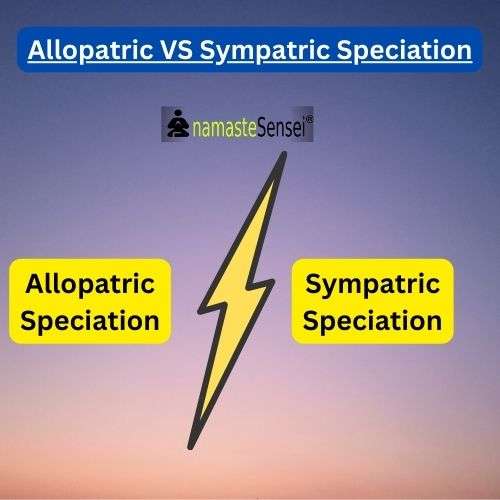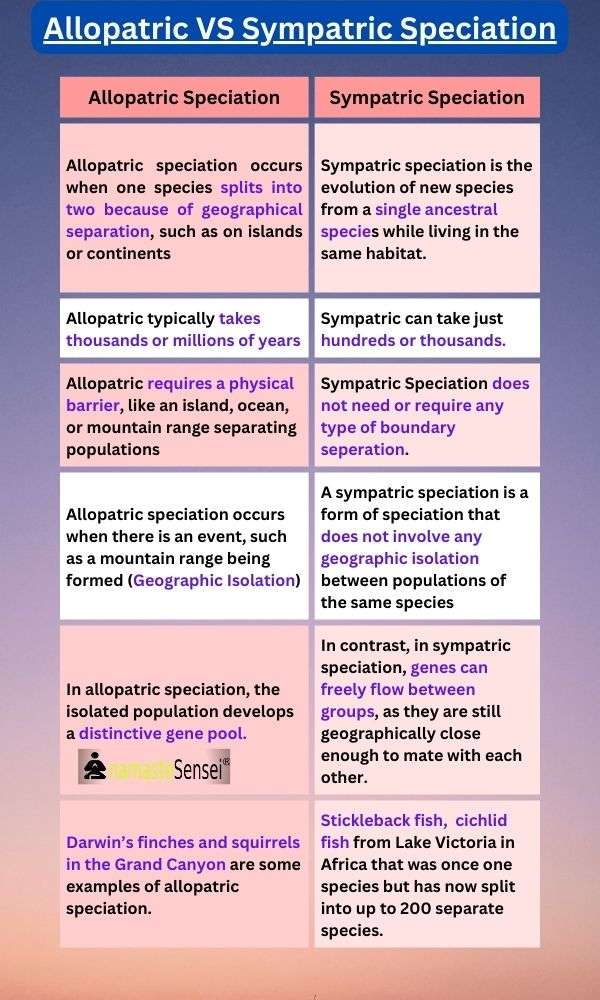allopatric vs sympatric speciation

Allopatric Vs Sympatric Speciation
A key question evolutionary biologists are trying to answer is how new species emerge and become distinct from one another.
One of the most widely accepted answers to this involves allopatric vs sympatric speciation, or speciation that takes place because of geographic separation, also called allopatry, versus speciation that occurs in the same place, also called sympatry.
Allopatric and sympatric speciation have different results in terms of gene flow between populations and the number of species on an island or continent, but they both play vital roles in explaining how biodiversity forms.
Differences between allopatric vs. sympatric speciation

Speciation is the process by which new species are formed. There are two different speciations, allopatric and sympatric speciation.
-
Basic Definition
Allopatric speciation occurs when one species splits into two because of geographical separation, such as on islands or continents that become isolated from each other by a physical barrier (e.g., mountain ranges).
Sympatric speciation occurs when a new species develops from an old species without geographic isolation, for example, if an individual mutates and then mates with another individual who also has the same mutation, creating a new species with different characteristics (e.g., color) than the original one.
-
Time Taken To Emerge
We can also think of allopatric and sympatric speciation in terms of how much time it takes for a new species to evolve. It took just 3-5 thousand years to make this evolutionary change.
The major difference between these two types of speciation is the time it takes to happen; allopatric typically takes thousands or millions of years, while sympatric can take just hundreds or thousands.
An example would be Darwin’s finches evolving over the course of 30 million years after they were geographically separated on different Galapagos Islands.
Sympatric speciation typically happens over only hundreds or thousands of years because there is no time needed to wait for natural selection to occur before mating with a new partner to create a new species.
An example would be gray wolves turning into coyotes in North America after they evolved alongside brown bears, but now have no competition so their teeth got smaller and their jaws got weaker.
-
Physical Barrier
Another difference between them is that allopatric requires a physical barrier, like an island, ocean, or mountain range separating populations, while sympatric does not need any type of boundary.
Species emerge in allopatric speciation, or when they are separated by a physical barrier like water or mountain ranges, at a much faster rate than in sympatric speciation. This is because the new species doesn’t have to compete with other members of the species for food and living space until they eventually meet again.
-
Geographical Isolation between species
Allopatric speciation occurs when there is an event, such as a mountain range being formed (Geographic Isolation), that causes two populations of the same species to become reproductively isolated from one another and no longer exchange genes with one another.
This type of speciation often results in the formation of new species because the two populations cannot mate and produce offspring anymore.
A sympatric speciation is a form of speciation that does not involve any geographic isolation between populations of the same species, meaning they can still mate and reproduce with one another despite living in proximity to each other.
-
Difference In Gene pool
Allopatric and sympatric speciation occurs when a new species evolves from an existing species because of the geographic separation or isolation of one or more populations.
In allopatric speciation, the isolated population develops a distinctive gene pool which eventually becomes so different from the original population that it can no longer interbreed.
In contrast, in sympatric speciation, genes can freely flow between groups, as they are still geographically close enough to mate with each other.
-
Examples of allopatric vs sympatric speciation
An example of allopatric speciation can be found in Darwin’s finches, which were found on different islands and developed unique traits over time as they adapted to their particular environments.
Examples of sympatric speciation can be seen in stickleback fish. One group with males who have spines for fighting has been mating with another group that lacks these spines, and this has resulted in the complete separation of these two groups.
Another good example is the cichlid fish from Lake Victoria in Africa that was once one species but has now split into up to 200 separate species due to local adaptation.
Recommeded Read: 10 Fascinating Examples Of Symaptric Speciation
Allopatric and sympatric speciation Conclusion
It’s not always easy to determine the difference between allopatric and sympatric speciation, but it’s helpful to understand the differences.
Allopatric speciation can happen when a population of a species is separated from its parent population by some geographical barrier, like a mountain or an ocean, for long enough that they evolve into a different subspecies of the same species. We also know this as geographic isolation. An example of this would be the Galapagos finches, where there are 18 varieties on the island because they’ve adapted to eat different seeds found in the area.
Sympatric speciation happens when two similar populations live in proximity with each other over time, so much so that they eventually become a new species because they don’t interbreed anymore and have developed new traits because of adaptations.
Congratulations, you have read the complete article about the Allopatric and sympatric speciation. If you have any doubts or queries, feel free to comment below. We will respond as soon as possible.
Or Email Us At [email protected]
Any topic you want us to cover? Let us know.
